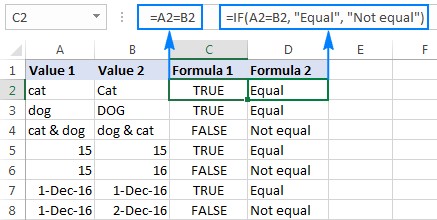Comparing strings in Excel is crucial for data accuracy and analysis. This guide provides various formulas for comparing text strings, whether you need a case-sensitive or case-insensitive match. We’ll cover comparing two cells, multiple cells, and even comparing a range of cells to a sample.
Case-Insensitive String Comparison in Excel
To compare two strings without considering case, use the simple formula:
=A1=B1This formula compares the values in cells A1 and B1 and returns TRUE if they are equal, and FALSE otherwise. For custom outputs, use the IF function:
=IF(A1=B1, "Match", "No Match")This will return “Match” if the strings are the same and “No Match” if they differ. This works for text, dates, and numbers.
Case-Sensitive String Comparison in Excel
For case-sensitive comparison, utilize the EXACT function:
=EXACT(A1, B1)This returns TRUE only if the strings in A1 and B1 are identical, including case. Like the previous example, you can customize the output:
=IF(EXACT(A1, B1), "Exact Match", "No Match")Comparing Multiple Strings in Excel
To compare more than two strings, combine the previous formulas with the AND function.
Case-Insensitive Comparison of Multiple Cells:
=AND(A1=B1, A1=C1)or
=IF(AND(A1=B1, A1=C1), "Match", "No Match")This checks if the value in A1 is equal to both B1 and C1.
Case-Sensitive Comparison of Multiple Cells:
=AND(EXACT(A1,B1), EXACT(A1,C1))or
=IF(AND(EXACT(A1,B1), EXACT(A1,C1)), "Exact Match", "No Match")This ensures all compared strings are identical, including case.
Comparing a Range of Cells to a Sample Cell
To compare a range to a single cell, use COUNTIF with ROWS and COLUMNS.
Case-Insensitive Range Comparison:
=IF(ROWS(A1:A10)*COLUMNS(A1:A10)=COUNTIF(A1:A10,B1),"All Match","Not All Match")This compares the range A1:A10 to the value in B1, ignoring case.
Case-Sensitive Range Comparison:
This requires an array formula (entered with Ctrl + Shift + Enter):
{=IF(ROWS(A1:A10)*COLUMNS(A1:A10)=SUM(--EXACT(B1,A1:A10)),"All Match","Not All Match")}Comparing String Length in Excel
To compare the length of two strings:
=LEN(A1)=LEN(B1)or
=IF(LEN(A1)=LEN(B1),"Equal Length","Different Length")Comparing by Occurrences of a Specific Character
To compare the number of times a specific character appears in two strings:
=IF(LEN(B2)-LEN(SUBSTITUTE(B2,$A2,""))=LEN(C2)-LEN(SUBSTITUTE(C2,$A2,"")), "Equal", "Not equal")This formula compares the occurrences of the character in A2 within strings in B2 and C2. This is useful for tasks like comparing order IDs.
By using these techniques, you can effectively compare strings in Excel for various data analysis and validation tasks. Remember to choose the formula that best suits your specific comparison needs.
